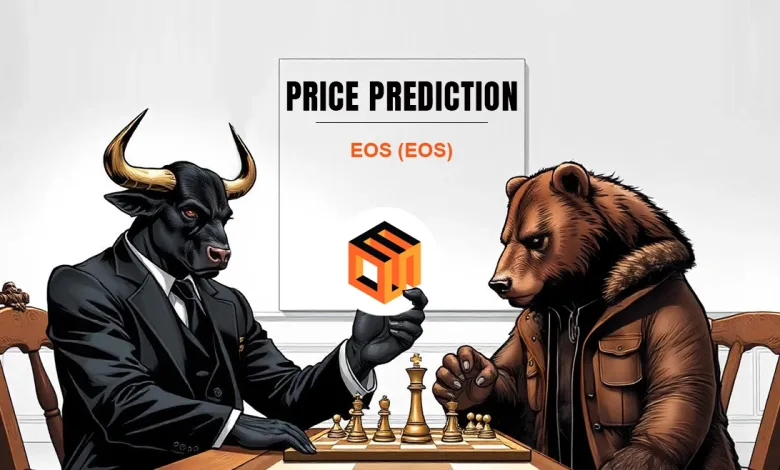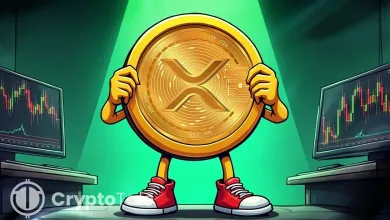EOS Price Prediction 2025-35: Will It Hit $150 by 2035?

- EOS derivatives trading volume surged to $3.17 billion, the highest since August.
- Rising on-chain activity indicates growing confidence in EOS’s long-term outlook.
- The token is expected to surge between $0.1 and $20 in 2025, driven by market optimism.
EOS (EOS) Overview
| Cryptocurrency | EOS |
| Ticker | EOS |
| Current Price | $0.7346 |
| Price Change (30D) | +39.15% |
| Price Change (1Y) | -27.83% |
| Market Cap | $1.14 Billion |
| Circulating Supply | 1.55 Billion |
| All-Time High | $22.89 |
| All-Time Low | $0.4015 |
| Total Supply | $2.1 Billion |
What is EOS (EOS)?
The EOS ecosystem is a decentralized blockchain infrastructure built to host, run, and manage scalable decentralized applications (dApps). Often likened to a blockchain operating system, EOS combines high throughput, developer accessibility, and democratic governance to deliver a full-stack environment for Web3 solutions. It is known for its performance, ability to handle large volumes of transactions, and unique resource model that separates it from fee-based chains like Ethereum.
The Origins of EOS
EOS was launched by Block.one in 2017 with an ambitious goal of overcoming the speed, flexibility, and cost limitations of existing blockchains. Its year-long initial coin offering (ICO) ran from June 26, 2017, to June 1, 2018, raising over $4 billion and becoming one of the largest ICOs in the industry’s history.
Dan Larimer, a notable blockchain developer known for projects like BitShares and Steemit, designed EOS’s architecture. His vision for EOS was to deliver an infrastructure resembling traditional operating systems, offering developers computing power, memory, and communication tools.
How the EOS Ecosystem Works
EOS operates using a Delegated Proof of Stake (DPoS) consensus mechanism. In this model, EOS token holders stake their tokens to vote for a select group of block producers who validate transactions and maintain the network.
The platform uses a three-resource model to allocate computing power:
- CPU: Executes smart contracts.
- RAM: Stores data needed for real-time processing.
- Bandwidth: Moves data across the network.
Users and developers do not pay fees per transaction. Instead, they stake EOS tokens to access network resources. This staking model enables predictable costs and encourages long-term participation.
EOS.IO and EOS Tokens
At the core of the EOS ecosystem is EOS.IO, the software layer that powers the blockchain. Similar to an operating system like Windows or macOS, EOS.IO manages permissions, schedules transactions, and enables vertical and horizontal scaling of dApps.
The native cryptocurrency, EOS, is used for:
- Staking to access resources
- Voting on governance proposals
- Delegating or renting resources to others
- Transacting within dApps built on EOS
Key Features of the EOS Ecosystem
EOS sets itself apart through several essential attributes:
- Scalability: Processing up to 1 million transactions per second using parallel execution.
- Free Transactions: Users don’t pay per transaction; they gain access based on token holding.
- Governance: Community-led decision-making enables updates, dispute resolution, and accountability.
- Account Management: Custom user accounts with authentication features improve access and security.
- Development Tools: A comprehensive toolkit supports efficient dApp creation and deployment.
EOS also allows staking flexibility, meaning token holders not actively using the network can rent bandwidth to other users, creating a resource-sharing economy within the ecosystem.
EOS Projects and Innovations
The EOS ecosystem has continued to evolve, launching several impactful projects:
- EOS EVM (Ethereum Virtual Machine): Enables developers to deploy Ethereum-compatible dApps on EOS, benefiting from lower fees and higher speed.
- PowerUp Model (2024): Users can top up their accounts with resources to execute free transactions for 24 hours, improving accessibility.
- DeFi Initiatives: EOS has supported decentralized exchanges, lending platforms, and other decentralized finance use cases.
- Governance Reform: New community-led voting mechanisms are being introduced to improve transparency and inclusiveness.
- Industry Partnerships: Collaborations with gaming and media tech firms have been formed to build specialized dApps that require high throughput.
EOS’s Governance Model
The EOS network features a governance layer where token holders vote on software rules, elect block producers, and even amend the network’s constitution. This makes EOS one of the few chains where users can actively shape the network’s future.
However, with great power comes risk. Block producers can freeze accounts, a mechanism designed to stop malicious activity but one that could also be misused if not properly regulated.
Moreover, block producer rewards are capped to prevent excessive power concentration to ensure inflation does not exceed 5% annually, and token holders can vote to remove producers acting against the network’s interests.
EOS Price History
After its debut in 2017, EOS made a striking upward move, reaching a peak of $22.89 in early 2018. This price marked its all-time high, but the rally quickly came to a halt. The token faced resistance near the $22 level, and soon after, it began a steady decline.
By late 2018, EOS had lost over 93% of its value, stabilizing between $2.68 and $1.55. This marked a crucial support zone, setting the stage for what seemed like a revival. In a surprising turn, EOS surged 458%, peaking at $8.65.
However, this rise was short-lived as the price hit the 38.2% Fibonacci retracement level, acting as resistance. The price soon retreated to its previous support range, where it began to form a falling wedge pattern. This formation is often seen as a signal of a potential bullish reversal.
EOS did manage a breakout from this wedge, briefly reaching $14.86 in May 2021. However, the price quickly retraced and closed below the upper boundary of the wedge. This confirmed that the price consolidation within the wedge was ongoing, though it was edging lower. By late November last year, EOS reached its all-time low of $0.4015, marking a new low after a prolonged downward move.
Since hitting the low, EOS has traded sideways, remaining in the same zone with slight upward movements. The token now shows signs of a possible reversal. A breakout above the upper arm of the falling wedge, followed by a close above it, could signal the beginning of a bullish trend.
Such a move could push EOS towards challenging resistance in the $8.65 to $9.44 range, bringing the token closer to its previous highs. On the other hand, if EOS fails to break above this key resistance, it could revisit its all-time low and drop further into new territory.
EOS Token Shows Strong Market Activity Amid Price Surge
The EOS token has seen a rise in futures open interest, reaching $212.44 million. This level marks the highest since September 2022, signaling growing market interest and increasing anticipation of a price move to the upside.
In parallel, EOS’s derivatives trading volume has also surged, peaking at $3.17 billion—a level not seen since August. This jump in trading volume derivatives reflects heightened confidence in EOS’s future performance.
These on-chain metrics suggest that market participants are becoming more active and speculative in their approach to EOS. The surge in both on-chain metrics points to a shift in sentiment, with more traders positioning themselves for possible bullish movements in the token.
Related: Gala Price Prediction 2025-35: Will It Hit $25 by 2035?
Yearly Highs and Lows of EOS
| Year | EOS Price | |
| High | Low | |
| 2024 | $1.5390 | $0.4015 |
| 2023 | $1.3412 | $0.4793 |
| 2022 | $3.2742 | $0.7861 |
| 2021 | $14.9436 | $2.3783 |
| 2020 | $5.5001 | $1.4307 |
| 2019 | $8.6600 | $2.1500 |
| 2018 | $22.89 | $1.5329 |
| 2017 | $6.9000 | $0.9891 |
EOS Technical Analysis
According to the monthly chart analysis, the MACD line, at -0.2172, is above the signal line of -0.2974, indicating a positive divergence that supports potential upward price movement. The histogram also shows positive momentum, with increasing green bars, signaling further bullish strength.
The MACD’s current position suggests the token is in a phase of momentum recovery, with a likely continuation of the upward trend if it remains above the signal line. Besides, the RSI, currently at 47.10, is approaching the neutral zone, indicating that EOS is moving toward more favorable market conditions.
Although still below the 50 level, the RSI shows a gradual increase from its lower range, suggesting that buying pressure is beginning to rise. If the RSI crosses the 50 threshold, it would further confirm the strengthening bullish momentum.
EOS (EOS) Price Forecast Based on Fair Value Gap
The chart shows a Fair Value Gap (FVG) area highlighted above the token’s current price action. The FVG stretches from $3.67 to $3.27, an area where EOS previously experienced rapid downward movement without much consolidation. This gap typically indicates a region of potential future price action, either for the token to fill this gap or face resistance.
EOS is currently trading near its all-time low, and the FVG zone represents an area where the token might encounter strong resistance if the price moves upward. The gap is critical to monitor since it reflects a range that could act as a ceiling or a support zone, depending on future price behavior.
Given the current low price, the FVG offers a price target for upward momentum. If EOS begins to rise, this zone will be essential in determining whether the price can break through and continue upward or reverse.
Should EOS successfully push through this area, it could indicate a change in trend. However, if the price fails to breach the FVG, it could reinforce the bearish market sentiment.
EOS (EOS) Price Forecast Based on MA Ribbon Analysis
The EOS/USD chart indicates an impending bullish move as EOS’s market value approaches and trades above the 20-period MA. Currently, the 20-period MA stands at 0.7023, while the 50-period MA is at 1.7362, with the former being below the latter.
This positioning suggests a bearish trend in the short term, but recent price action shows a rising momentum as EOS breaks the 20-period MA resistance. If EOS manages to sustain a surge above the 20-period MA, this would signal a shift in market sentiment, suggesting a reversal to the upside.
The price crossing above this key short-term moving average marks the beginning of a more sustained bullish trend. Yet, given that the 50-period MA is still above the 20-period MA, there remains a challenge ahead.
A confirmed break above the 20-period MA, followed by continued upward movement, could suggest that EOS is ready to challenge the 50-period MA, paving the way for a more significant recovery. This potential shift would signal an impending bullish move for the token. If it fails to break above the 50-period MA, it could decline to the 20-period MA or even lower.
EOS (EOS) Price Forecast Based on Fib Analysis
The EOS/USD chart shows that the token is trading below all key Fibonacci retracement levels, positioning it close to the 0% level at $0.40. The price action is hovering just above this low, with the token facing strong resistance at higher Fibonacci levels.
The key levels to monitor are the 23.6% retracement at $5.7128, the 38.2% level at $8.9989, the 50% level at $11.6549, and the 61.8% level at $14.3108. At present, EOS is still far from reaching these levels, with the price significantly below them.
The 38.2% and 50% levels, in particular, represent essential resistance zones that the token must break through for a meaningful recovery. Should EOS break above these levels, it could signal a shift in the trend, moving toward the higher levels at 61.8% and 78.6%.
The current position of EOS below these key Fibonacci levels indicates a weak market structure, but if the token starts to push upward, the retracement levels will act as critical resistance points.
EOS (EOS) Price Prediction 2025
According to our price forecast, EOS is expected to peak post-BTC halving, reaching between $0.1 and $20. This price increase will be fueled by market optimism as the crypto market enters an expansion phase with a post-halving rally and heightened investor interest.
EOS (EOS) Price Prediction 2026
After the market correction triggered by overvaluation and euphoria post-halving, EOS could experience a downturn, dropping to $8-$15. This year will reflect the typical market recession phase as the crypto market corrects itself and struggles with price sustainability.
EOS (EOS) Price Prediction 2027
EOS is projected to enter a recovery phase as investor confidence returns, ranging between $5 and $12. The market shows signs of stabilization, with renewed hope as the BTC halving draws near, leading to a likely bull run towards the following year.
EOS (EOS) Price Prediction 2028
Following another Bitcoin halving cycle, EOS is predicted to reach between $15 and $35. This period is expected to experience bullish sentiment as BTC’s influence boosts the entire market, pushing EOS toward its next peak within the long-term cycle.
EOS (EOS) Price Prediction 2029
After Bitcoin’s halving, EOS is expected to surge between $30 and $50. With rising adoption and expanding use cases for blockchain technology, EOS is set to reach its next peak, benefiting from both BTC’s post-halving surge and growing decentralized application (dApp) demand.
EOS (EOS) Price Prediction 2030
EOS may experience another significant correction this year, with the price range falling to $12-$30. This dip will follow the market downturns observed post-peak as the market adjusts and stabilizes before the next bullish cycle begins.
EOS (EOS) Price Prediction 2031
According to CryptoTales’s projections, EOS could bounce back from the market’s depression, with prices stabilizing between $25 and $40. Investors regain confidence as the market recovers, aided by the next BTC halving cycle and renewed investor interest.
EOS (EOS) Price Prediction 2032
By 2032, EOS is expected to recover fully, with prices soaring between $40 and $80. EOS will position itself as a leading force in crypto, breaking through previous resistance levels and reaching new highs amid the sixth BTC halving event.
EOS (EOS) Price Prediction 2033
Following a full recovery, EOS could experience a strong expansion, reaching between $60 and $100. This growth will be fueled by the continued success of the blockchain ecosystem and the increasing demand for Web3 solutions as EOS solidifies its role in the DeFi and dApp markets.
EOS (EOS) Price Prediction 2034
In 2034, EOS might face a slight retracement, with prices ranging between $45 and $85. Despite this minor correction, the token will remain stable as it consolidates its position in the market, aided by its solid technological foundation and market support, retaining investor confidence.
EOS (EOS) Price Prediction 2035
EOS is projected to hit an all-time high in 2035, with prices ranging from $90 to $150. With the ongoing rise of blockchain technology, broader adoption, and the next BTC halving event fueling the crypto market, EOS will reach new heights, surpassing its previous all-time high and making essential progress within the industry.
Related: COMP Price Prediction 2025-35: Will It Hit $5,000 by 2035?
FAQs
EOS is a decentralized blockchain platform designed for scalable dApps. It offers high throughput, developer accessibility, and free transactions using a Delegated Proof of Stake (DPoS) consensus.
EOS can be purchased using Bitcoin, Ethereum, or fiat currency on various cryptocurrency exchanges like Binance, Kraken, and Bitstamp.
Investing in EOS depends on market conditions and personal risk tolerance, but it has potential due to its scalability and growing adoption in Web3 and decentralized finance.
EOS should be stored in a secure wallet, such as a hardware wallet (Ledger or Trezor) or software wallet (Scatter or Greymass), to ensure private key safety.
EOS was created by Dan Larimer, known for founding BitShares and Steemit, and developed by Block.one, which raised over $4 billion during its ICO.
EOS was launched in 2017 after a year-long ICO that ended in June 2018.
EOS has a circulating supply of 1.55 billion tokens, with a total supply of 2.1 billion tokens.
Depending on market trends, technological developments, and increasing blockchain adoption, EOS could surpass its all-time high of $22.89.
EOS’s lowest price was $0.4015, reached in late November 2024.
EOS is projected to reach between $0.1 and $20 in 2025, driven by market optimism post-BTC halving and a rally in the crypto market.
In 2028, EOS is expected to reach between $15 and $35, boosted by rising blockchain adoption, technological advancements, and the influence of Bitcoin’s halving.
EOS could range between $12 and $30 in 2030, experiencing a market correction before the next bullish cycle fueled by blockchain growth.
By 2032, EOS is expected to soar between $40 and $80, driven by technological advancements, increased adoption, and the sixth Bitcoin halving event.
EOS is predicted to reach an all-time high between $90 and $150 in 2035, thanks to rising blockchain adoption, technology, and the next Bitcoin halving cycle.





